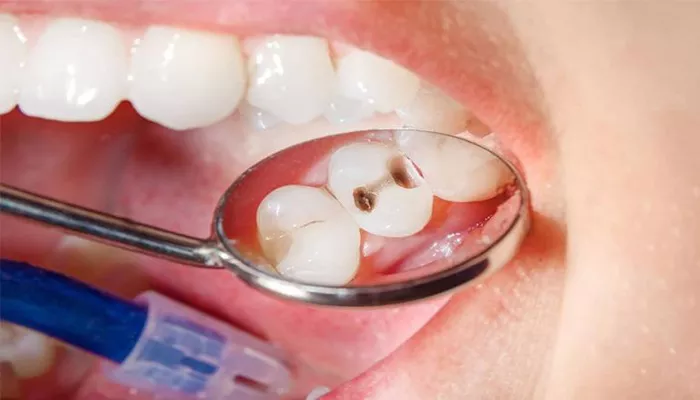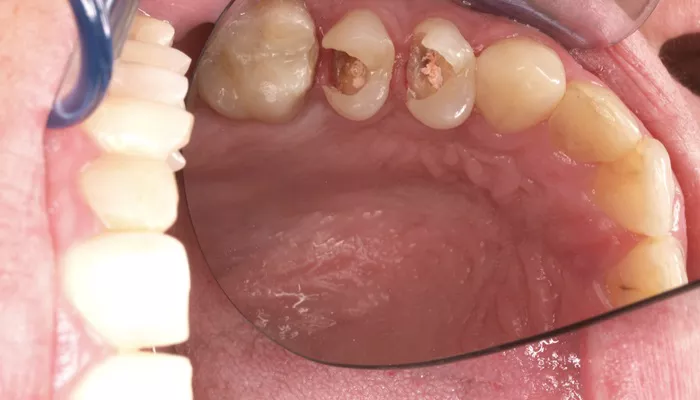caries symptoms
Caries symptoms can vary depending on the stage of the decay. Early stages of tooth decay may not produce any noticeable symptoms, but as the decay progresses, several signs can appear. Here are the common symptoms of caries:
1.Tooth Sensitivity: A mild to severe sensitivity to hot, cold, or sweet foods can be a sign of early-stage caries. As the enamel is worn away, the dentin beneath it becomes exposed, which is more sensitive to stimuli.
2.Visible Holes or Pits: As the decay advances, cavities may become visible as darkened spots, holes, or pits on the surface of the teeth. These are often seen on the biting surfaces, along the gumline, or between the teeth.
3.Pain: Pain is a common symptom when caries progress to deeper layers of the tooth, especially if it reaches the pulp, which contains nerves. This pain may be intermittent or constant, and it can be triggered by chewing or pressure.
4.Bad Breath: Persistent bad breath (halitosis) or an unpleasant taste in the mouth can occur as a result of the bacteria involved in the decay process.
5.Tooth Discoloration: Teeth affected by caries may take on a yellowish, brown, or black color, especially as the decay spreads deeper into the tooth structure.
6.Swelling and Abscesses: In severe cases of caries, an infection may develop, causing swelling in the gums and the formation of abscesses. This could lead to an acute dental emergency requiring immediate attention.
caries risk assessment
Understanding and identifying caries risk is vital for effective prevention and management. Several factors contribute to an individual’s susceptibility to caries. These factors include:
1. Diet
A diet high in sugars and carbohydrates contributes significantly to the development of dental caries. When foods rich in sugar or starches are consumed, the bacteria in the mouth break them down into acids that can erode the tooth enamel.
2. Oral Hygiene Habits
Poor oral hygiene is a major factor in the development of caries. Inadequate brushing and flossing allow plaque and bacteria to accumulate on teeth, leading to acid production and enamel breakdown.
3. Saliva Flow
Saliva plays a crucial role in neutralizing acids and remineralizing teeth. Individuals with reduced saliva flow (due to medication, medical conditions, or dehydration) are at a higher risk of developing caries.
4. Age
Both young children and older adults are at higher risk of developing caries. Children may have less effective oral hygiene habits, while older adults may experience dry mouth or receding gums, which increases vulnerability to decay.
5. Previous History of Caries
A person who has had cavities in the past is more likely to develop them again in the future. Regular dental checkups and preventive treatments, such as fluoride treatments, are essential in reducing this risk.
6. Social and Behavioral Factors
Lifestyle factors such as tobacco use, alcohol consumption, and irregular dental visits can increase the likelihood of developing caries.
7. Genetics
Genetic factors play a role in the strength of tooth enamel and the way an individual’s saliva functions. Some people may have naturally stronger enamel or more acidic saliva, making them more prone to tooth decay.
Dental professionals often use a combination of these risk factors to assess an individual’s risk for developing caries and recommend appropriate preventive measures.
caries treatment
Once caries has been diagnosed, the treatment depends on the severity and stage of the decay. There are several treatment options available:
1. Fluoride Treatments
In the early stages of tooth decay, fluoride treatments can help remineralize the enamel and stop the decay process. This is usually done in a dental office but can also be managed at home with fluoride toothpaste and mouth rinses.
2. Fillings (Restorations)
If the decay has progressed to form a cavity, the damaged portion of the tooth is removed, and the cavity is filled with a dental material. Common filling materials include composite resin, amalgam, and gold.
3. Crowns
In cases where the decay is more extensive and has weakened the structure of the tooth, a crown may be placed over the tooth to restore its function and appearance. Crowns are often made from materials like porcelain, metal, or a combination of both.
4. Root Canals
If the decay reaches the tooth’s pulp (the innermost part containing nerves and blood vessels), a root canal may be necessary. During this procedure, the infected tissue is removed, and the cavity is cleaned and sealed. A crown is often placed afterward to protect the tooth.
5. Tooth Extractions
In extreme cases where the tooth is so badly decayed that it cannot be saved, a tooth extraction may be required. After extraction, the dentist may recommend options such as implants, bridges, or dentures to replace the missing tooth.
6. Preventive Treatments
Preventive treatments include regular cleanings, fluoride varnishes, and dental sealants, which protect the teeth from future decay. Sealants are typically applied to the chewing surfaces of the back teeth to protect them from cavities.
FAQs about Caries
1.What is meant by the cavity?
Cavities or tooth decay is the most common health problem across the globe. A cavity is a small hole in the outer layer (enamel) of a tooth. It’s permanent damage to the hard surface of teeth in forms of tiny holes. Usually, cavities start small, and later on, it becomes bigger if they are untreated.
Sometimes a cavity does not cause pain in the initial stage, so it’s difficult to realize a problem exists. A regular dental check-up is an optimal way to recognize the tooth cavity and start early treatment.
2.What Is the connection between diet and cavities?
Your diet plays a significant role in cavity development. Consuming excessive sugary and acidic foods and drinks can accelerate the formation of cavities. Bacteria in your mouth thrive on sugars and produce acids that attack your teeth. To reduce your cavity risk, limit your intake of sugary snacks and beverages, and opt for a balanced diet rich in fruits,vegetables, and dairy products.
3.Are cavities contagious or hereditary?
Cavities themselves are not contagious, but the bacteria responsible for causing cavities can be transmitted from person to person through saliva. This means that sharing utensils or engaging in activities that involve saliva exchange, such as kissing on the mouth, can potentially transfer cavity-causing bacteria.
While cavities are not directly hereditary, genetics can play a role in your susceptibility to dental issues. Some people may have genetically weaker enamel or be more prone to developing cavities.


